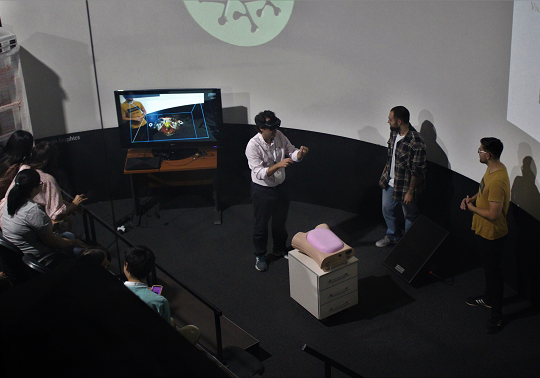
The Institute on Robotics and Information and Communication Technologies (IRTIC) presented, during the Route to Innovation held at its facilities on Friday 14 and Saturday 15 October, the projects that the ARTEC group is carrying out in the health sector. The conference highlighted the relationship between medicine and technological innovation, showing various initiatives and examples of application of both virtual and augmented reality.
Thanks to the innovative work developed by the group, using a virtual reality helmet, a small room can become an operating room where an intervention can be planned based on real patient data. Using augmented reality glasses, the real model of a human torso reveals the organs inside to facilitate the training experience for healthcare staff.
With the support provided by virtual reality, it is also possible to set up other training scenarios, such as a virtual newborn baby to be diagnosed in its first minutes of life. In this case, the teacher can modify the different parameters such as saturation, skin tone, respiratory effort, etc., so that the students can practice diagnosing the newborn.
The participants were able to see these experiences for themselves. They also attended a presentation of the activities and funded projects that ARTEC has carried out in recent years in the health sector.
In this way, the importance of ongoing projects such as MiRARAs, ViPRAS, Neodiag-VR or VISIBLE-US has been pointed out. MiRARAs (GV/2021/037, funded by Conselleria de Innovación, Universidades, Ciencia y Sociedad Digital) focuses on the process of stereoscopic video annotation to improve training related to robotic surgery.
The ViPRAS project (PID2020-114562RA-I00, funded by MCIN/AEI /10.13039/501100011033) investigates new methods of surgical planning using mixed reality. Neodiag-VR (AP-2021-004, funded by the VLC-Bioclinic programme of the University of Valencia and INCLIVA) shows a virtual neonate for diagnostic training, where its movement, reactions to stimuli and even its appearance are configurable.
The last one, VISIBLE-US (TED2021-132131B-I00 funded by the Spanish Ministry of Science and Innovation) investigates the use of real cadaver sections as a basis for creating new tools to help in the training for the use of ultrasound scanners.
These are some of the examples presented during the Route to Innovation, where visitors were also able to try out the simulators for port cranes, mining trucks and forklift trucks that the institute's LSYM group has at its disposal.
Images:






.jpg)
.jpg)
.jpg)
.jpg)
.jpg)
.jpg)
.jpg)













